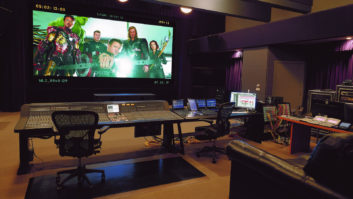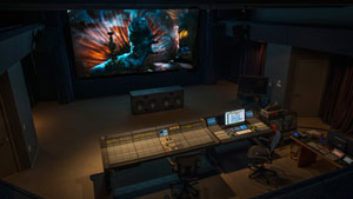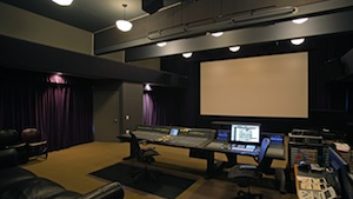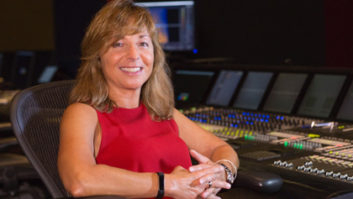Dennis Sands loves his work, and it shows. A three-time Oscar nominee for Best Sound (Cast Away, Contact and Forrest Gump), a TEC Award nominee and a winner of two Golden Reel Awards for Best Sound Editing-Music, he’s reached an enviable place in his career: working daily with the best composers and the best musicians on the best stages. Sands has more than 100 feature film scores to his credit, and he’s adding more all of the time. As either music, scoring and/or re-recording mixer, he’s worked on such high-profile films as Erin Brockovich, American Beauty, Pleasantville and Good Will Hunting. He’s also accumulated an impressive album discography with projects for luminaries such as Joe Pass, Sarah Vaughan, Ella Fitzgerald and the Count Basie Orchestra, along with numerous soundtrack albums.
Yes, life is good for Mr. Sands. It’s also good for the people who get to work with him. His years of experience and relaxed style make for smooth and even — dare we say? — fun sessions, a talent that’s prized in the high-pressure world of feature films.
I first sat down with Sands on the Warner Bros. scoring stage after he’d spent a day mixing music with composer Alan Silvestri for Showtime, the Tom Dey-directed buddy cop spoof starring Robert De Niro and Eddie Murphy. The huge control room was filled: a big synth setup in one corner, a wall of converters, signal processing and computers in another, and behind that, a jam-packed machine room. Every fader of the 96-input SSL 9000 J was in use. Outside the control room, the stage was set for the next day’s session with a 98-piece orchestra. As we wandered among the maze of microphone booms, baffles, music stands and chairs, Sands clued me in on his philosophy and techniques.
It looks like you’re doing pretty much back-to-back sessions.
We finish here Saturday night, then I start SpiderMan with Danny Elfman on Sunday at Sony — two quite massive projects, but it seems like most projects are massive now. Even this [100-input] board is sometimes too small.
There do seem to be a lot of machines in here…
We’re recording to a 48-track digital — a Sony HR machine. There’s usually an additional analog machine for synthesizers, and I also record orchestra to analog. Then we’ll probably have another machine for choir. So, we’re using at least three analog 24s and a digital 48, and even that…
…isn’t enough?
There’s a lot going on — a hundred and some odd tracks, and it can be more. When we did Planet of the Apes, I had to have three additional DA-88s running. We did that at Fox, which has the same board as here, and they had every single fader filled, plus I had to bring in sidecars. Projects are just expanding.
Why is that?
Some of it’s my choice because I like to have flexibility and control; not so much with the orchestra, but certainly with synths. And if I’m working with Danny, he uses a lot of stereo samples, so every sound requires two channels.
Also, mixes are expanding, and I like to have the ability to create surrounds. Then, of course, they’ll want elements separate for the dub: percussive elements separate from pads, which are separate from orchestra. And if you have choir, that’s separate. It’s more and more complex. Here’s a board that’s relatively new in design, and it’s right on the edge of being obsolete. It’s not the manufacturer’s fault. It’s just so hard to keep up with the demands. Then you add in the fact that the typical post-production schedule has shrunk down a lot. Directors are continually editing and changing. That affects us, and we have to allow for it.
It’s just part of the job these days.
It’s the way the business is now. There’s so much money involved, and there can be so much tension. But when you understand everybody’s issues and problems, you can’t really get angry with anyone. Everybody’s under the same time pressure and everybody’s trying to do the right thing. You have creative people who want to maximize what they do, and there are time constraints. It’s a frustration that everybody has to deal with.
I’ve heard it suggested that things will improve when everybody is on the same computer system, getting the changes at the same time.
[Laughs] Actually, I have this great fear. I was thinking about digital distribution of movies, whether over the Internet or whatever, when it dawned on me what could happen: A movie would not necessarily have to be completed by the release date! The director will be able to say, “Okay, the movie’s done, but there’s a cue in reel two that really bothers me and I want to replace it.” The release print was always the cutoff, but that doesn’t mean anything if you’re downloading digitally. You can have endless new versions.
You could spend your whole life on just one movie.
[Laughs] Actually, sometimes it seems like I’ve done that already.
You’re all set up for tomorrow, except for the mics. I guess you take them down every night.
If mics are left up, there literally has to be a guard in the room with them all night. A lot of the mics are irreplaceable; you can’t even put a dollar amount on them. Like my four M50s. I use them on every orchestral project. If anything happened to them, I would be heartbroken.
The M50s are your main overhead mics?
Yes, for the orchestra. They’re wonderful microphones, and they only made 600, of which there are probably 400 left in the world. They were the first purchase I made as a mixer, and I treat them better than I do my children.
Can you describe your setup of the musicians?
There are two basic setups I use. This is a traditional one: [audience left to right] first violins, second violins, violas toward the center, cellos with bass behind them, piano to the right, or sometimes I’ll pull a piano out of the orchestra so it’s right in front. Harp is in front, also. French horns in back, woodwinds in the middle, brass and trombones over to the right, percussion in the back.
You have the percussion more baffled.
There are two Latin percussionists, and I kind of isolate them. If percussion is too much out in the room, it gets washed out and you hear a bit of delay. It just doesn’t sound good, so I try to contain it as much as possible.
The rest of the setup is very open.
I don’t use many baffles for orchestra. I prefer to control the dynamics out in the room. And I don’t use a lot of microphones. I have a fair amount set up, but most of them I use just for spot if I want to reach for something here or there. Mostly for orchestra, I use about a dozen. Usually five room mics: the three M50s and two Klaus Heyne-modified Brauner VM1s. Dirk Brauner, who’s German, makes a contemporary tube mic that Klaus modifies fairly extensively. I’ve had them less than a year and I think it’s the best-sounding contemporary tube microphone. It’s also very expensive.
You can buy it stock, but modified is much richer-sounding. Klaus handpicks them. Dirk sends him 20 or 30 mics, and, for example, if he has a client who wants a great vocal mic, he’ll go through them and find the one that’s best for that. In my case, he found two mics that matched as closely as possible and, in his opinion, were best suited for scoring, left and right wide.
Where else do you put overheads?
I like percussion overheads. I’m not big on percussion in your face, and if it was a classical recording, I probably wouldn’t use the overheads. But for film, where you’re dealing with sound effects and dialog, you want a little more presence to help it cut through. You still want to keep it in the room, in the same perspective with some nice depth to it, but a little more presence and texture helps. It’s subtle, but it makes a difference. So I’ll use B&K 4006s on left and right; in the center, I have a U47 over the timpani.
I like to put the timpani in the middle, particularly with Alan Silvestri. He often writes a lot of it, like in last year’s The Mummy Returns. It was in everything, very rhythmic, almost like a drum kit, and I love the sound of it in the middle. Some classical composers have it set off to the side; it’s a personal taste. To me, in the center, it gives a nice power — both in the room and coming off of the screen.
So your setups change, depending on the style of the composer.
To a degree. The other setup, which Danny Elfman likes, is, we’ll split the violins: firsts on the left, seconds on the right. Violas go mid-left, cellos mid-right and basses in the middle. Danny’s orchestrator Steve Bartek orchestrates for this setup, giving it a beautiful quality where the violins answer one another. Sometimes it’s harder on the musicians because, typically, violin players want to sit next to one another. It helps their intonation. But they’ve been great, and it has really worked on the last few movies. Also, having the basses in the middle, there’s something nice about having that low stuff right in the center.
What are your other mic preferences?
I love the Schoeps CMC 54 and use it on harp and woodwinds. I’ll use the Sennheiser MKH 40s, Neumann KM84s or B&K 4011s for the violas. I use two Stephen Paul-modified U87s for the celli, and on basses, I use Soundelux U96s. I am fortunate enough to own a matched pair of Neumann KM54s, and I always use them for the piano. I mike the brass two ways: M-149 overall, and Coles 4038s (trombones) and Royer M-121s (trumpets) for solos.
You work regularly at several different studios.
As far as scoring, there are really five facilities in Los Angeles: Warners, Sony, Fox, Todd-AO and Paramount. I move around. We’re fortunate here to have these five really excellent facilities and what comes with them: Excellent crews that understand film work. It’s really very different from record work.
What are some of those differences?
Cue systems, for one. For example, string players typically like to hear only clicks, but percussion players want to hear the whole mix, plus click. If we have pre-records and we want to hear just the piano part, or just the percussion part, these facilities are set up for a number of different cue systems and they have someone to operate them. If you go to a facility accustomed to doing record work and it’s running to rent the video machines, it’s very hard on a mixer. I just don’t have time to train people and also do my job.
A film is a world unto itself, and a big part of my job is dealing with the politics. There are more people involved, and everybody needs to have an understanding of who’s who and when to say something and when not to. It’s all part of the job. And it’s a great job; there’s always something to learn, something to get excited about.
Do you listen in 5.1 surround while you’re recording?
Yes. My three main monitors are PMCs, tri-amped, with a built-in X-curve, the film equalization curve. I always use them for mixing. There are subwoofers, and the surrounds here — a JBL system — are actually built into the side and back walls.
You don’t switch between systems while you’re working?
No. I use this system for mixing. When I’m scoring, I use another set that are full-range: ATC Model 100s with Entec subwoofers. They have built-in power amps. Although, for this project, we’ll continue on with these that are specifically for film mixing (for the scoring), because it’s too much to move them in and out.
How many channels are you mixing to?
This is a 16-channel mix. There are four stems: percussion, orchestra, a stereo extra and five channels of synthesizers. We usually mix to two machines and Tascam MX-24. Essentially, we’re mixing Pro Tools files; the drive goes out to the Pro Tools system. This has been a wonderful addition, because you don’t have to deal with Pro Tools here, which often falls offline and can slow you down. They’re also a pain to set up and interface. So this works great. I use Genexes for backup; the studio takes them and has the mixes archived automatically.
What else is in the racks here?
I have Neve 1081 mic preamps for scoring. Then there are converters, 16 channels. I like the dB Technologies 122s. And I use an outboard folddown mixer. We’re always having to do two tracks for soundtrack albums, but there’s rarely an opportunity to do a separate 2-track mix, so I use an outboard mixer to take the 16 stems and create a 2-track.
Sorry, but the only word for all this routing is “awesome.”
That’s this man here: Greg Dennen. It does take a few minutes to set up. [Laughs] Just to transition to the mix from scoring is a good eight or nine hours. It wouldn’t take that long if it were just an orchestral score, but we have all the electronics and they need a lot of reverbs to create ambience. Then, to split it all out means that there’s more tracks, so there are more things to patch.
These guys have to check everything out and make sure everything’s patched right, that it’s a clean signal, on and on. There’s no quick way to do it. Again, as mixes and complexity grow, the time required to get it together grows.
What else is in your rack? I see a lot of Millennia logos.
I like Millennia a lot. We have some Avalons, Manleys, some GMLs, which are great. The nice thing about it is, they all have a little bit of a sound to them. The Millennia probably are the least colored. It’s nice to have a selection to get the right combination of sounds.
Obviously, you’re using the SSL 9000 J Series console preamps also.
We are. The 9000 is a great-sounding board. The preamps are really good. I was never an SSL fan, but this console has completely changed my perspective on it in terms of sonics.
Can we back up for a little history? How did you get into scoring?
My first studio job was for MGM’s record company when I was 22. A friend of my brother’s who worked there called me because they had a huge tape library and they needed someone to administer it.
You were looking to get into film?
I just wanted to get into music; I didn’t really know that much about film or television. Working there taught me a lot. The studio had three rooms, and I got to know the mixers. It wasn’t a rock ‘n’ roll studio; the mixers were more traditional, very experienced guys who were mixing a lot of Steve Lawrence and Eydie Gorme, Sammy Davis Jr., Frank Sinatra; I just loved it. I loved pop and rock, but the orchestra got me. When I wasn’t working, I’d just hang out. I lived at the studio; I didn’t want to leave. One night, we scored a film and it was the most thrilling thing I’d ever done.
After I was there about six months, they taught me record mastering because the mixers didn’t want to do it. Then at night, if there were nothing going on in the studio, I’d take a tape into a room and started learning on my own.
One Friday night, there was a session booked with Joe Pass, and the mixer showed up so wasted he couldn’t even stand. Every other mixer was gone; I was the only guy there who knew how to work the equipment — it was me or the guard, and the guard didn’t want do the take! I was nervous at first, and then I was fine. It was just so great.
The producer liked me, so he started asking for me, and I did more and more of his records. After a while, I’m doing Count Basie and Ella Fitzgerald, Oscar Peterson; amazing things. I couldn’t even believe I was sitting there engineering.
Eventually, MGM sold the studio. I stayed with them and did administrative stuff, but it wasn’t what I wanted to do. I’d hit it off with another mixer at MGM; we formed a partnership and started doing record dates. Our business grew, we started doing television shows, and we got the idea to build our own studio and to focus on television work. No one else was doing it. So in 1977, we opened Group IV in Hollywood. It was the first really modern recording facility available to the television and film worlds.
The great thing was, I really learned how to mix there, because at that time, TV used live musicians and it was all mixed live. Not only that, I’d be doing two different shows a day: one in the morning, one in the afternoon. Different composers, completely different styles. I worked on Dallas; I did the show where J.R. got shot! Hill Street Blues, St. Elsewhere, I met Alan Silvestri doing CHiPs. And we also started doing some film work.
The studios at Group IV weren’t that big; it must have been cozy doing orchestras!
For Romancing the Stone, which was a pivotal movie for me and a lot of other folks, we had 56 musicians and they were absolutely jam-packed. I had four musicians in the control room: the electronic drum kit and three keyboard players behind me. Then the director, Bob Zemeckis, Michael Douglas and who ever else was hanging out. It was too cozy! We had one iso booth that had two guitars and bass, then strings and brass and percussion. But it was a hit movie, and it was such an innovative score. It was Bob Zemeckis’ first hit movie; the same for Danny DeVito and for Alan Silvestri. Prior to it, Michael Douglas had been doing the Streets of San Francisco. It was a real special project. People saw it and liked it, and I got phone calls and started to get more and more into film work.
Do you read music?
I taught myself. I do better mixes because I can follow it, understand it, see what the concept is. It helps me adjust the dynamics in a room, which I much prefer to do rather than reach for the fader. If I feel bar 23 would be great if we heard more trombones, I’d rather say, “Let’s do another take and have the trombones play louder.”
Do you get the score beforehand?
No. But I try to get the movie with its work track and temp music, particularly if I’m going to dub it also. I do about two movies a year where I’ll also dub. Not too many people do that, but Bob Zemeckis gave me the opportunity, starting with Back to the Future III.
How else do you prepare for a session?
I do a fair amount of homework. I’ll have a number of conversations with the composer about what approach we’re looking for. And I can tell a lot of things just by looking at how many and what types of musicians.
If it’s a straight orchestral score, I don’t need to ask much. But when there’s a lot of electronics, there’s more planning involved. Then I do the right kind of setup and the right kind of preparation in the control rooms with the right machinery.
Are you a harsh taskmaster with people who work for you?
They’re not scared of me! I think it’s important to be easygoing. We’re all human beings; we all make mistakes. If people are diligent, try hard, that’s all you can ever ask of them. I think it’s important not to freak out because the mixer sets the tone. If the mixer is obviously tense and nervous and seems concerned, everyone else is going to be the same way. There will be tension and you don’t want that; there’s enough tension on a film. The last thing in the world that you want is for there to be a sense that you’re nervous or concerned.
Sometimes, people are scared when they walk into a control room. It’s not their world, and it’s got to be frightening when you know you’re dependent on this but it looks so unbelievably complex. If you sense the operator is tense and nervous and you know there’s a big meter running, you’re going to be really uncomfortable. So I go out of my way to stay very calm.
Was that always your style or did that develop over time?
Certainly, experience relaxes you a lot. There just aren’t many things that can happen that I can’t fix. But I think I’ve always been calm and good with people. As I say, I understand that people walk in and they’re nervous. Directors have a lot of pressure on them. Studios have a lot of pressure on them. There’s a lot of money on the line and I understand that.
I have great respect for the business; I really do. I’m very appreciative to be here, and I want people to have a good time. It’s all an experience. You want the technology invisible. It doesn’t have to be a miserable experience, a tension-filled experience. You can do good work and still have fun doing it.
I love what I do, and I think of myself as an artist. I don’t think of myself as a technician at all. I don’t care why something works. To me, these are all tools to create the sonic experience. And I feel very fortunate to be able to work in this environment and this kind of job. I’ve had a real job before, and this is way better!
Maureen Droney is Mix‘s Los Angeles editor.
SELECTED FILM CREDITS
Men in Black II (2002) (music scoring mixer)
SpiderMan (2002) (music scoring mixer)
Planet of the Apes (2001) (scoring mixer)
Legally Blonde (2001) (scoring mixer)
Cast Away (2000) (sound re-recording mixer)
Erin Brockovich (2000) (music mixer)
American Beauty (1999) (music mixer, music recordist)
Pleasantville (1998) (music scoring mixer)
The Horse Whisperer (1998) (score mixer, score recordist, sound re-recording mixer)
Good Will Hunting (1997) (score mixer, score recordist)
Contact (1997) (music scoring mixer, sound re-recording mixer)
Independence Day (1996) (score mixer)
Eraser (1996) (score mixer)
The American President (1995) (score mixer)
While You Were Sleeping (1995) (music recordist, music scoring mixer)
Richie Rich (1994) (music scoring mixer)
Forrest Gump (1994) (music recordist, sound re-recording mixer)
Gettysburg (1993) (scoring mixer)
Bram Stoker’s Dracula (1992) (sound re-recording mixer)
The Last of the Mohicans (1992) (score mixer)
The Abyss (1989) (score mixer)
Who Framed Roger Rabbit (1988) (score mixer)
Back to the Future (1985) (music scoring mixer)
Romancing the Stone (1984) (music scoring mixer)
On Golden Pond (1981) (music recordist)






